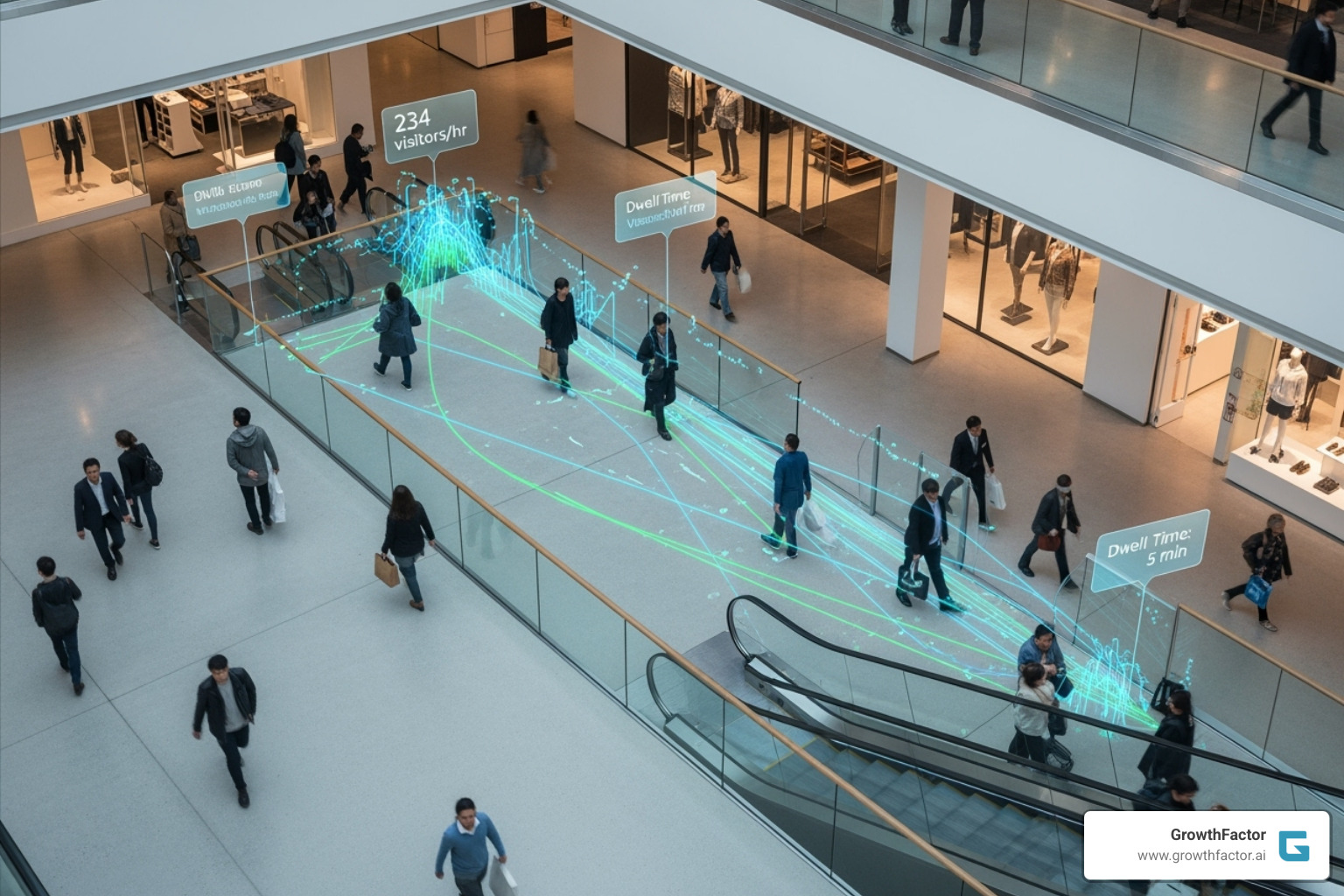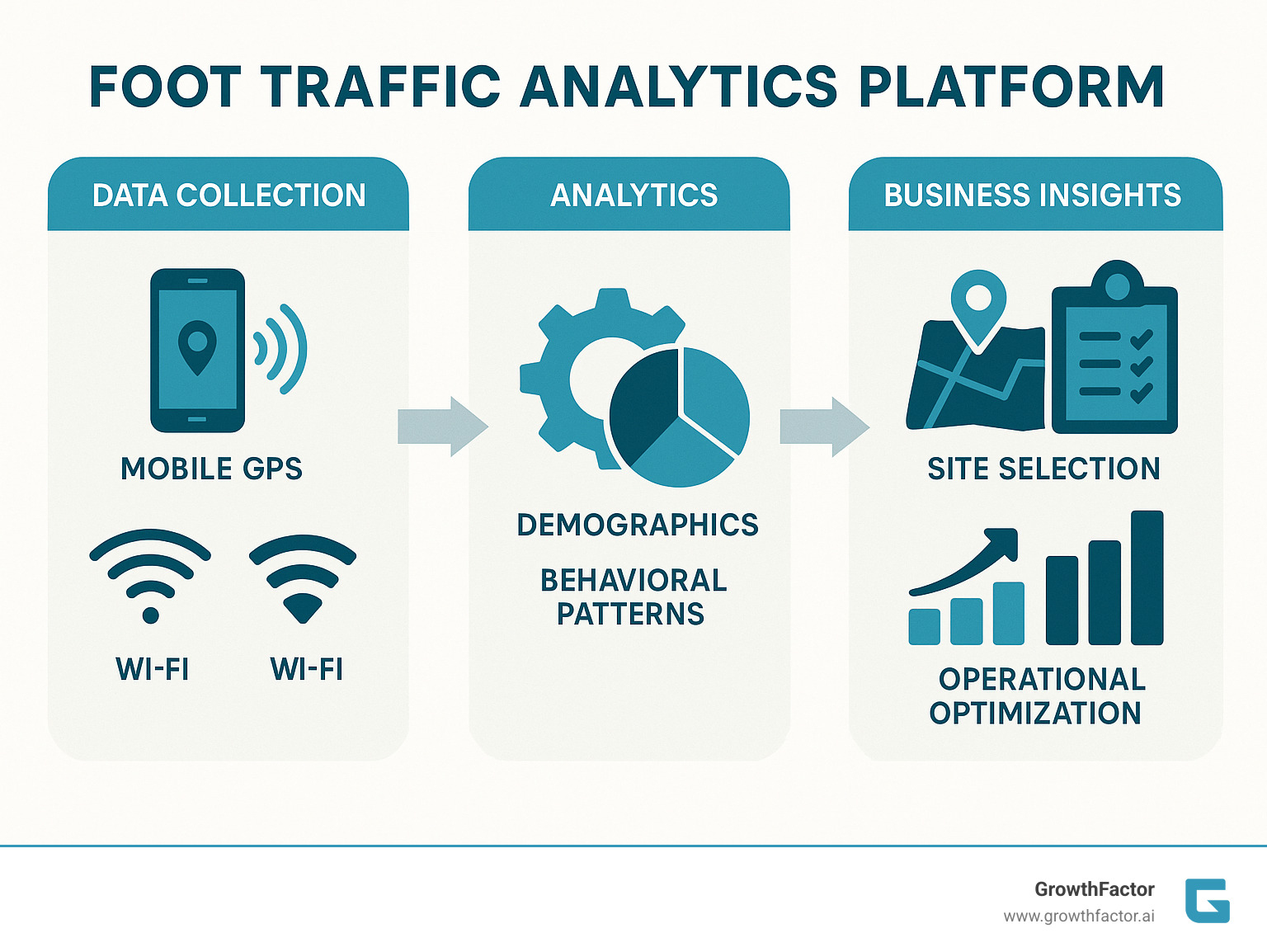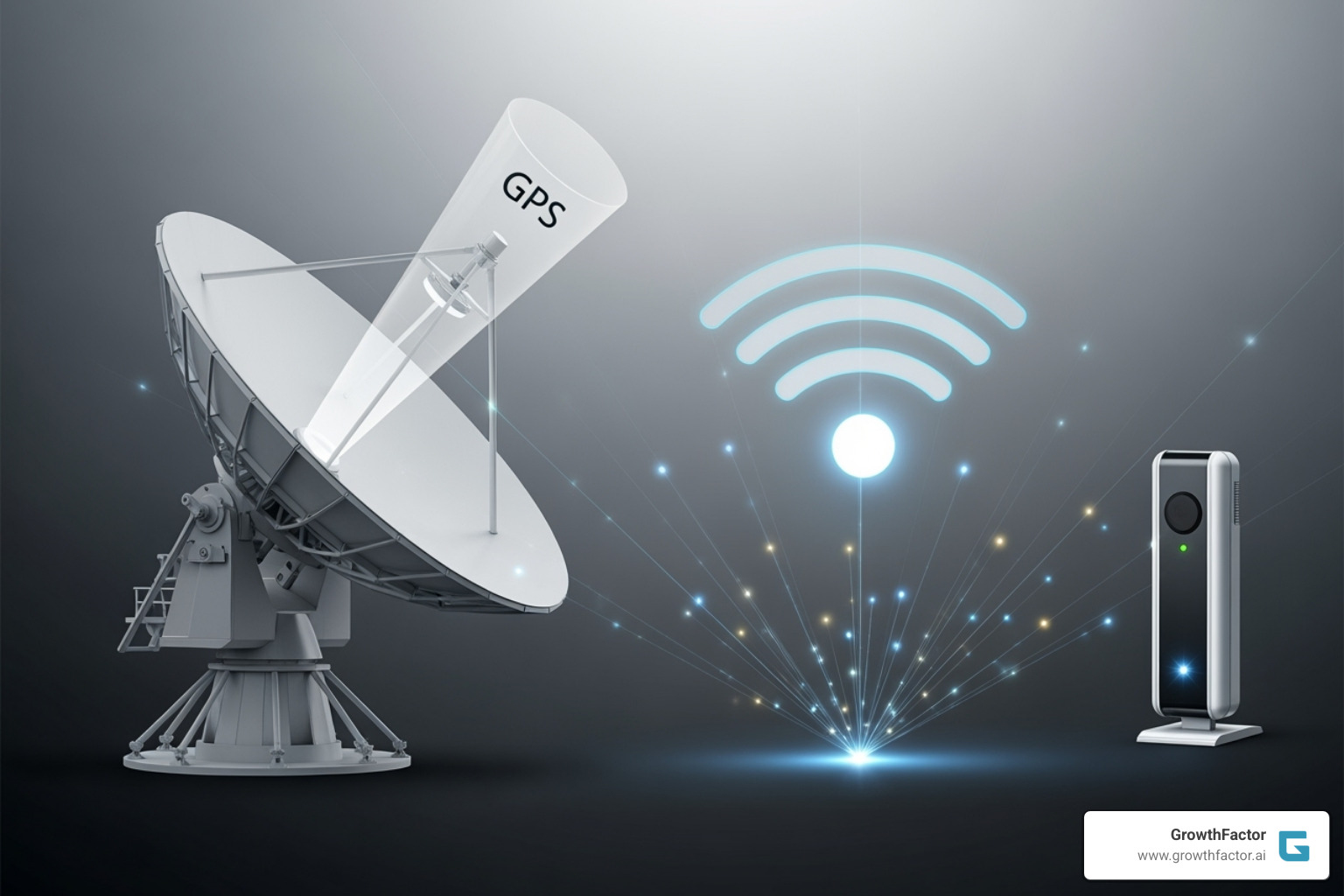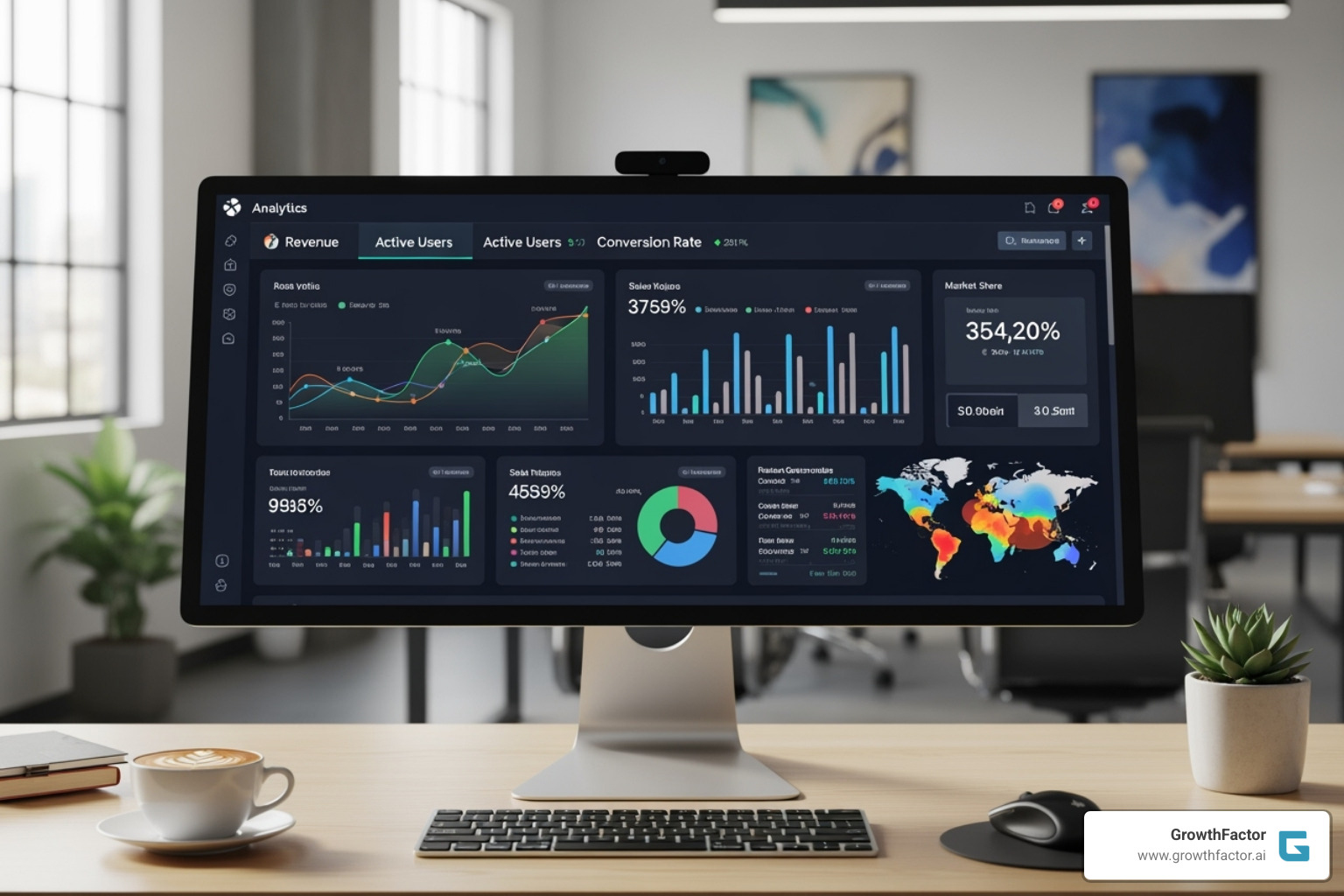Walk This Way: Uncovering the Best Foot Traffic Analytics Platforms
Why Every Step Counts in Modern Retail

A foot traffic analytics platform is a technology solution that measures, analyzes, and provides insights about pedestrian movement in and around physical locations. These platforms help businesses understand visitor patterns, demographics, and behaviors to make data-driven decisions about site selection, operations, and marketing strategies.
Key Components of Foot Traffic Analytics Platforms:
- Data Collection Methods: Mobile GPS tracking, thermal sensors, Wi-Fi analytics, and video systems
- Analytics Capabilities: Real-time reporting, predictive modeling, demographic insights, and competitive benchmarking
- Business Applications: Site selection, performance optimization, marketing measurement, and operational planning
- Integration Features: API access, POS connectivity, dashboard visualization, and custom reporting
With retail foot traffic growing just 0.4% year-over-year in 2024, the stakes for retail expansion are high, and every location choice is critical. Smart retailers now use sophisticated analytics, moving beyond gut instinct to process millions of data points for near real-time insights.
Modern platforms use machine learning trained on 120+ features to achieve R-squared validation scores up to 0.93. They combine anonymized mobile data with demographics and competitive intelligence for a complete view of a location's potential.
The technology has evolved beyond simple people counting to offer features like 25-meter radius precision mapping and predictive revenue forecasting. Some platforms process over a billion data points monthly, while others offer easy-to-deploy hardware.
As CEO of GrowthFactor.ai, I've seen these platforms transform retail expansion. We helped Cavender's Western Wear triple their store growth while hitting 100% of revenue targets. The key is finding a solution that fits your scale, whether you have 5 locations or 500.

Must-know Foot traffic analytics platform terms:
Understanding the 'How': Methods of Foot Traffic Data Collection
A foot traffic analytics platform gathers evidence about how people move through physical spaces using several data collection methods. Understanding these methods is key, as it directly impacts the quality and type of insights you'll get from your platform. Some methods excel at broad market analysis, while others provide pinpoint accuracy within your four walls.

Mobile Location Data (GPS & Guides)
Mobile location data, the backbone of modern foot traffic analytics, uses anonymized signals from millions of mobile devices. It captures GPS, Wi-Fi, and cell tower signals, which machine learning models then process to reveal not just visitor counts, but also their origins and demographics. By analyzing movement patterns, platforms can infer visitor age ranges, income levels, and lifestyle preferences with high accuracy, with some providers achieving R-squared validation scores up to 0.93.
This method is highly scalable, allowing for analysis across entire states or regions without any hardware installation. It's invaluable for spotting emerging neighborhoods, identifying underserved markets, and validating customer behavior patterns. Learn more about how AI improves this process in our guide to AI Location Intelligence.
In-Store Hardware Sensors
While mobile data provides a broad view, hardware sensors offer a microscopic look inside your locations.
- Thermal sensors are a cutting-edge, privacy-conscious option. They detect body heat rather than capturing images and are often wireless, making setup quick and easy without needing IT support.
- Infrared break beam sensors act as invisible tripwires at entrances, reliably counting entries and exits.
When combined with a point-of-sale system, sensor data allows you to calculate conversion rates, identify peak hours, and optimize staffing based on actual traffic patterns. Hardware is ideal for answering operational questions about staffing efficiency, entrance usage, and customer browsing times.
Wi-Fi & Video Analytics
These methods offer more detail than basic counters but different insights than mobile data.
- Wi-Fi network tracking detects mobile devices to create heat maps showing how people move and linger in your space. Its main limitation is that it only tracks devices with active Wi-Fi.
- Video analytics uses AI to analyze existing CCTV footage to count people, track movement, and measure dwell times. This allows for retroactive analysis of busy periods but comes with higher costs and significant privacy considerations.
The most robust foot traffic analytics platform solutions often combine multiple collection methods, using each approach's strengths to create a complete picture. The right mix depends on whether you're optimizing existing stores or scouting new markets.
Core Capabilities of a Modern Foot Traffic Analytics Platform
Choosing the right foot traffic analytics platform is about finding a partner that helps you make smarter decisions. It's not just about counting visitors; it's about open uping insights that improve your bottom line. Here's what separates powerful platforms from basic ones.

Data & Analytics: What to Look for in a Foot Traffic Analytics Platform
The data engine is the core of the platform, and accuracy is the most important metric. Look for platforms with high accuracy, validated by R-squared scores up to 0.93. This precision, combined with near real-time insights, allows you to react quickly to market changes.
Platforms with five or more years of historical data enable you to spot long-term trends and create reliable forecasts. The real game-changer is AI-powered predictive modeling, which shifts decision-making from reactive to proactive. For retailers, this can revolutionize inventory and staffing, as detailed in our guide to AI-Powered Retail Analytics. The best platforms also enrich data with demographic and psychographic insights, turning traffic counts into actionable customer intelligence.
Integration & Usability: How a Foot Traffic Analytics Platform Fits in Your Stack
Sophisticated data is useless if it's inaccessible. A good platform must integrate with your existing tools and be easy for your team to use.
- Intuitive dashboards are essential. Data should be presented through clean visualizations and interactive heat maps that tell a clear story.
- API access provides the freedom to feed insights into your existing business intelligence tools or build custom applications. This ensures you're never locked into a vendor's limitations. Explore more about API integration benefits.
- POS and CRM integration is vital for retailers. Connecting visitor counts with sales data open ups powerful metrics like conversion rates and revenue per visitor.
A sophisticated platform supports unified commerce by connecting physical store performance with digital marketing. This creates a complete customer view and delivers measurable benefits, such as improved TCO and faster implementation, by breaking down data silos.
Key Approaches to Foot Traffic Analytics Platforms
Not all foot traffic analytics platforms are the same. They generally fall into three main categories: mobile data-driven approaches that leverage smartphone signals, hardware-based solutions that rely on physical sensors, and hybrid approaches that combine multiple methods for comprehensive insights. Understanding these distinctions is crucial for selecting a platform that serves your business goals.
Mobile Data-Driven Approaches
These platforms analyze anonymized signals from mobile devices—GPS coordinates, Wi-Fi connections, and cell tower pings—to understand movement patterns. Advanced algorithms use cleansed GPS signals to create verified visits to specific points of interest (POIs), filtering out false positives like delivery drivers.
By analyzing movement over time, these platforms build detailed consumer personas with inferred demographics and lifestyle preferences. Some use blueprints mapping technology to understand visitor flow within large retail complexes. The primary advantage is scalability, allowing you to analyze any location without installing hardware, making it ideal for competitive intelligence and site selection.
Hardware-Based Solutions
Hardware-based platforms use physical devices for precise, on-site data capture. Thermal sensor technology is a leading example, offering privacy-compliant counting by detecting body heat instead of capturing images. These sensors are often battery-operated and easy to install. WiFi analytics is another hardware approach that detects mobile devices scanning for networks, providing insights into repeat visitors and movement patterns.
The strength of hardware lies in direct measurement. It provides the ground truth needed to calculate conversion rates, optimize staff schedules, and get precise counts during specific events like sales.
Hybrid and Visualization-Focused Approaches
The most sophisticated platforms are hybrid, combining the external market insights of mobile data with the in-store precision of hardware sensors. This creates a comprehensive view of visitor behavior. Geodata visualization is crucial for translating these complex datasets into intuitive formats like heat maps and dynamic charts.
These platforms excel at the integration of custom datasets, allowing businesses to merge foot traffic data with sales figures, weather patterns, or local events to uncover hidden correlations. By using multi-method tracking, some platforms can achieve hyper-local precision down to a 25-meter radius, which is valuable for large or mixed-use properties.
Solving Business Challenges with Foot Traffic Analytics
A foot traffic analytics platform transforms site selection from guesswork into a data-driven growth strategy. At GrowthFactor, we've seen how the right data turns business challenges into competitive advantages by telling the story behind customer footsteps.
Data-Driven Site Selection and Expansion
Smart site selection is the most game-changing application of foot traffic analytics.
- Identifying high-potential locations is simplified with real-time foot traffic data overlaid on demographic information, replacing outdated census reports.
- Void analysis reveals gaps in the market, such as a high-traffic area lacking a specific type of retailer, identifying untapped opportunities.
- Trade area mapping shows where potential customers actually live and work, revealing a location's true reach.
- Fleet rightsizing becomes data-driven, making decisions to close underperforming locations or expand successful ones clearer.
Our AI Agent Waldo automates this qualification process, enabling teams to evaluate five times more sites efficiently. For more strategies, see our Retail Site Selection Analysis.
Gaining a Competitive Edge
Foot traffic analytics provides smart, legitimate competitive intelligence.
- Competitive intelligence reveals patterns financial reports can't, such as a competitor's true foot traffic versus yours.
- Performance benchmarking allows you to objectively compare your traffic against similar businesses in similar locations.
- Understanding visitor profiles of competitors can reveal new market segments to target. For deeper techniques, explore our insights on AI Real Estate Market Analysis.
Optimizing Operations and Marketing
Foot traffic data also serves as an operational compass for daily decisions.
- Store layout optimization uses heat maps to show where customers go, helping you place high-margin products in prime spots.
- Staff scheduling aligned with traffic patterns reduces labor costs while improving customer service.
- Inventory planning becomes more precise by understanding which products are in high-engagement zones.
- Measuring marketing campaign lift provides concrete ROI by showing how many additional visitors your campaigns generated.
For strategies on turning data into sustained growth, explore our resources on attracting High Foot Traffic.
Frequently Asked Questions about Foot Traffic Analytics
When businesses first explore a foot traffic analytics platform, they naturally have questions. Here are the most common concerns we address.
How accurate is foot traffic data?
Accuracy depends on the collection method. Hardware sensors like thermal or infrared devices can achieve over 95% accuracy for entry and exit counts. Mobile location data, when processed by sophisticated machine learning models, can also be highly accurate for analyzing broader movement patterns. Leading platforms report R-squared validation scores up to 0.93 against ground truth data. The key is the quality of the algorithms and the size of the data panel. While no method is perfect, modern platforms provide reliable, actionable data for business decisions. Always ask providers about their validation methodologies.
What are the data privacy and security considerations?
Responsible providers build their platforms with privacy at the core to address valid concerns about location data. The gold standard involves stripping personally identifiable information (PII) at the earliest possible stage and aggregating movements into broad, anonymized patterns. Platforms are built with a privacy-by-design architecture, where technologies like thermal sensors inherently protect identity.
Reputable platforms strictly adhere to global privacy regulations like GDPR and CCPA, which includes transparent data collection, user consent, and robust opt-out procedures. When evaluating platforms, always ask about their privacy policies and compliance certifications.
What are the future trends in foot traffic analytics?
The future of foot traffic analytics is driven by AI and the need for unified customer insights. Key trends include:
- Deeper AI Integration: Moving beyond pattern recognition toward predictive and prescriptive models that recommend specific business actions.
- Data Fusion: Seamlessly merging foot traffic data with transactional records, weather patterns, local events, and social media sentiment for a richer context.
- Unified Commerce: Connecting physical store visits with digital touchpoints to create a holistic view of the customer journey across all channels.
- Hyper-local Precision: Offering granular analysis (e.g., 25-meter radius) for operational tactics while also providing macro-level insights for strategic planning.
For deeper insights into how AI is changing the field, explore our guide on AI Location Intelligence.
Conclusion: Finding the Right Platform for Your Growth
Choosing the right foot traffic analytics platform is crucial for business success in a competitive landscape. After exploring the technology, from mobile data to thermal sensors, it's clear that understanding customer movement is essential for survival and growth.
With retail foot traffic showing minimal growth, every location decision and operational insight can mean the difference between thriving and merely getting by. The right platform transforms data into actionable strategies that drive real results.
When evaluating platforms, focus on what matters most to your business. Data accuracy, backed by validation metrics like R-squared scores, should be non-negotiable. Integration capabilities with your existing POS and CRM systems are vital for open uping the data's full potential. Finally, ensure the platform has a robust approach to privacy and security to protect your customers and your brand.
For businesses in retail real estate, the stakes are even higher. That's why we built GrowthFactor's AI-powered platform. Our AI Agent Waldo automates the site qualification and evaluation process, helping teams examine five times more potential sites with greater confidence and speed. We've seen clients like Cavender's Western Wear triple their store growth while hitting 100% of their revenue targets.
Better data leads to better decisions, which in turn drives sustainable growth. The future belongs to businesses that can turn every customer step into a strategic advantage.
Explore how AI-driven site selection can transform your real estate strategy.
Citations
The human algorithm
Ready to see what we're cooking?
Submit your information below and we'll be in touch to schedule.



